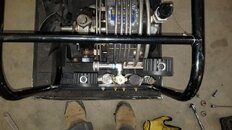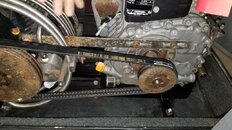Yea, I know another RIX thread ...  I've read and followed most (all?) of the RIX threads on here and tried to integrate the narrated experiences of @tbone1004 and @rob.mwpropane in particular and the ongoing wisdom of @iain/hsm but there is always more to know.
I've read and followed most (all?) of the RIX threads on here and tried to integrate the narrated experiences of @tbone1004 and @rob.mwpropane in particular and the ongoing wisdom of @iain/hsm but there is always more to know.
At some point in the not too distant future, I am hoping to be in a situation that requires a compressor, so purchasing could be next week or a few years - all depends on if and when the "right" unit at the right price comes along. My likely target would be some variant of SA-6. I have some reconfiguration questions, but my real hope is to aggregate information that will allow for sound purchase decisions since buying a new pump does not seem to be an option going forward. As evidenced in my old thread on one found unit: There be pigs! (RIX SA-2: Is there such a thing?) and I don't want a money pit.
To get it out of the way, Reconfiguration/Modification:
Pre-purchase: Selection and Inspection:
At some point in the not too distant future, I am hoping to be in a situation that requires a compressor, so purchasing could be next week or a few years - all depends on if and when the "right" unit at the right price comes along. My likely target would be some variant of SA-6. I have some reconfiguration questions, but my real hope is to aggregate information that will allow for sound purchase decisions since buying a new pump does not seem to be an option going forward. As evidenced in my old thread on one found unit: There be pigs! (RIX SA-2: Is there such a thing?) and I don't want a money pit.
To get it out of the way, Reconfiguration/Modification:
- Assuming that the separator "towers" are re-plumbed to be orientated vertically, is there any reason that the pump can't be run in a vertical orientation? Would fan-up vs. fan-down matter, or is there a reverse-direction fan to pull rather than push if it would be convection/cooling as the limiting factor?
- Some uses (ex. 48VDC Power Systems with battery banks) lend themselves to quiet, compact, fumeless electric drive and I have found some 4kW, 1500RPM motors that might be a good match (understanding the 17% capacity reduction due to lower RPM). Is there any reason that the motor couldn't be mounted inline with a three-piece coupling (a flange adapter would need to be mounted to the drive-pulley face)?
- Does anybody have any experience with inter/after-cooling setups for lower operating temps and enhanced moisture extraction? Water-cooling is of particular interest in a marine application or as part of a bigger thermal management scheme in confined mounting situations.
Pre-purchase: Selection and Inspection:
- Assuming that most sellers are not going to allow the unit to be messed with more the pulling the shroud for inspection and what would otherwise be normal operation, are there any good tests beyond what @iain/hsm outlined in @rob.mwpropane 's Filter tower thread (Filter Tower Question) Strikethrough is not likely possible and underlined is alternate.
[snip]At the front of the cooling shroud in the 6 o'clock position is a small bolt running through the steel 1 inch frame that holds the shrould in place, remove it and clean any grease and muck inside, inspect the two rubber grommets at each side of the block that hold the back of the shroud in two half cups. Replacing the grommets are cheap the plastic shroud isnt.Clean off any muck dirt and grease you can see and behind the main swach plate bearing and the 3 rose head bearings clean the 2 thrust rider plates (they are hardened steel and sharp) in the 6 o'clock position and note a small blue spring on the alignment trapeze right side.Lever off the decop lever on the engine or better yet remove the belts and turn the pump slowly by hand clockwise when viewed from the fan end (front) looking like a hawk on that blue spring to see if it moves if it does you may be out of alignment. If not and its rock steady your goodthen re grease using polyura grease (blue) the thrust rider plates and the lower twin bearing race use your finger.Next inspect the 3 rose head bearings at the end of each piston rod. Pull and push them checking for a loose race or wornif OK re grease them via the zerk grease nipples 5 pumps on the low pressure setting using an Alemet Pistol grip grease gun model 555-E dont waste your time using junk from China, if you do use a cheap nasty grease gun from your local Home Depot or whaterver you Yanks have that supports Chinese junk imports then you will understand where all that grease flinging about the place inside the fan shroud came from.Check belts for tension open drain valves, fit air intake air filter at the end of a 1" OD 3/4" ID PVC flexible hose use food grade tubing it wont off-gas or smell use jubille clips to attatch each end.Fit an interstage gauge (1500 psi range) to the second stage relief valveFit HP charging line with a pressure gauge to say a scuba cylinder with the valve closed at all times and fire it up.Run for 10 seconds then close the two drain valves and see if it builds up pressure. At 3000 psi or near to open the 3rd stage bleed valve for five seconds then close it then open the 2nd stage bleed valve also about 5 secondsAt the same time collect the discharge water from each stage drain and inspect for junk and stuff laterWhile the compressor is running you can use the 3rd stage bleed to throttle the flow and not exceed the say 3000 psi or the relief valve will open. But keep it at a minimum 500 psi. Then when you are ready close all the drains and if required let it run back up to 3000 psi . Then stop the engine.While stopped but still under pressure wait for 10 seconds check for leaks.Specifically on the 2nd stage intermediate gauge if its rising then your 3rd stage inlet valve is leaking back high pressure, if its falling then the 2nd stage discharge valve is leaking back.Then check the HP 3rd stage gauge if its falling then you have a leak or the inlet valve is weeping back,Conversly if the 3rd stage pressure is still rising then the engine is still running and your deaf.That or the gauge needle is in the process of falling off.If you dont have a second stage gauge fitted a cheap alternative trick is to drain the 2nd stage to empty while the 3rd stage is full but then re close the 2nd stage drain valve and wait another 10 seconds and open again, if the 3rd stage inlet valve is leaking back you get a clue if more air drains out of the 2nd stage separator after a 10 seconds hold from empty.[snip]
- Is there any reference sheet available that would help me to determine if it is a "late" model with the improvements and good parts support/availability based on model/serial numbers?
- Are all versions OK to run for HP/Cave fills with 3rd stage OP valves adjustable to 3800psi?





